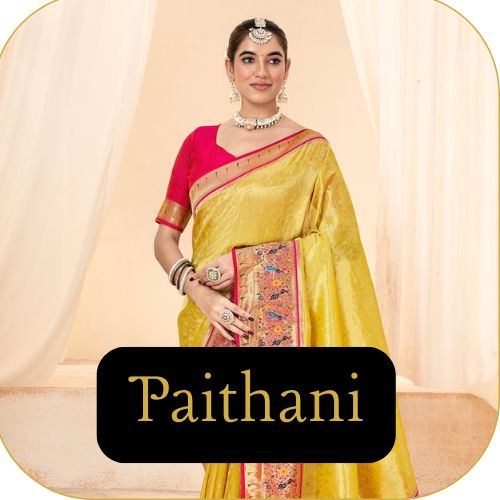India’s saree is not just a garment; it’s a rich tapestry of culture, tradition, and artistry that spans across various regions of the country. Each region boasts its own distinctive weaving techniques, patterns, and styles, reflecting the diverse cultural heritage of India. In this blog, we will explore the regional variations in saree weaving, uncovering the unique characteristics and historical significance of sarees from different parts of India.
1. Kanjeevaram Sarees: The Regal Weave of Tamil Nadu
Overview:
Kanjeevaram sarees, originating from Kanchipuram in Tamil Nadu, are renowned for their grandeur and opulence. These sarees are often associated with South Indian weddings and formal events.

Key Features:
- Fabric: Made from luxurious silk.
- Weaving Technique: Traditional handloom weaving with rich zari work.
- Designs: Intricate patterns including peacocks, temples, and floral motifs, often with contrasting borders and pallus.
- Colors: Bold and vibrant colors like gold, red, and green.
Historical Significance:
The Kanjeevaram saree dates back to the Chola dynasty and is celebrated for its durability and rich craftsmanship. It is a symbol of elegance and royalty in South Indian culture.
2. Banarasi Sarees: The Heritage of Varanasi
Overview:
Banarasi sarees hail from Varanasi in Uttar Pradesh and are known for their luxurious fabric and elaborate designs. These sarees are often worn by brides and for special occasions.

Key Features:
- Fabric: Primarily silk, with variations including organza and georgette.
- Weaving Technique: Jacquard loom weaving with intricate zari and brocade work.
- Designs: Elaborate patterns featuring floral motifs, paisleys, and religious symbols.
- Colors: Rich and opulent colors such as gold, silver, maroon, and deep green.
Historical Significance:
Banarasi sarees have been a part of Indian culture for centuries, with their origins tracing back to the Mughal era. They are considered a symbol of traditional craftsmanship and luxury.
3. Chanderi Sarees: The Grace of Madhya Pradesh
Overview:
Chanderi sarees from Madhya Pradesh are known for their light, airy fabric and elegant designs. They are ideal for both formal and casual occasions.
Key Features:
- Fabric: A blend of silk and cotton, resulting in a light, sheer texture.
- Weaving Technique: Handloom weaving with subtle but intricate patterns.
- Designs: Simple motifs such as geometric patterns, stripes, and checks.
- Colors: Soft pastel shades and light hues.
Historical Significance:
Chanderi sarees have been produced since the 7th century and are famous for their delicate texture and craftsmanship. They were once worn by royalty and have become a staple for modern fashion.
4. Mysore Silk Sarees: The Silk Tradition of Karnataka
Overview:
Mysore silk sarees from Karnataka are celebrated for their softness, sheen, and quality. They are often worn at special ceremonies and celebrations.

Key Features:
- Fabric: Pure silk with a soft and smooth texture.
- Weaving Technique: Handloom weaving with minimal zari work.
- Designs: Simple yet elegant patterns with a focus on the richness of the silk.
- Colors: Classic colors such as cream, gold, and deep shades of green and red.
Historical Significance:
Mysore silk has been produced since the 16th century and is known for its fine quality. The Mysore silk saree is an emblem of luxury and refinement.
5. Paithani Sarees: The Tradition of Maharashtra
Overview:
Paithani sarees from Maharashtra are known for their elaborate designs and vibrant colors. They are a favorite choice for weddings and festive occasions.

Key Features:
- Fabric: Silk, with intricate zari work.
- Weaving Technique: Handloom weaving with traditional motifs.
- Designs: Traditional peacock motifs, lotus flowers, and intricate borders.
- Colors: Bright and lively colors like pink, red, and orange.
Historical Significance:
Paithani sarees have a rich history dating back to the 2nd century. They are named after the town of Paithan and are revered for their intricate craftsmanship and vibrant hues.
6. Kota Doria Sarees: The Lightness of Rajasthan
Overview:
Kota Doria sarees from Rajasthan are known for their lightness and breathability, making them perfect for hot climates and casual wear.
Key Features:
- Fabric: Cotton with a fine texture, often blended with silk.
- Weaving Technique: Handloom weaving with a distinctive checkered pattern.
- Designs: Simple, with checkered patterns and light embellishments.
- Colors: Soft, soothing colors and pastels.
Historical Significance:
Kota Doria sarees have been a part of Rajasthan's textile tradition for centuries and are known for their airy, lightweight fabric.
7. Tant Sarees: The Comfort of West Bengal
Overview:
Tant sarees from West Bengal are valued for their comfort and practicality, making them ideal for daily wear and casual events.

Key Features:
- Fabric: Cotton, known for its breathable and lightweight qualities.
- Weaving Technique: Handloom weaving with simple patterns.
- Designs: Minimalistic designs with subtle borders and pallus.
- Colors: Bright and vibrant colors, often with traditional patterns.
Historical Significance:
Tant sarees have been woven in West Bengal since ancient times and are known for their comfort and durability. They reflect the simplicity and elegance of Bengali culture.
India’s saree weaving traditions are a testament to the country’s rich cultural diversity and artistry. From the opulent Kanjeevaram and Banarasi sarees to the light and airy Kota Doria and Chanderi sarees, each region offers unique characteristics and historical significance. Exploring these regional variations not only highlights the artistry involved but also allows you to appreciate the rich tapestry of Indian textile heritage.
Whether you’re a saree enthusiast or a first-time wearer, understanding these regional variations can help you choose the perfect saree for any occasion and celebrate the diverse beauty of Indian craftsmanship.
















